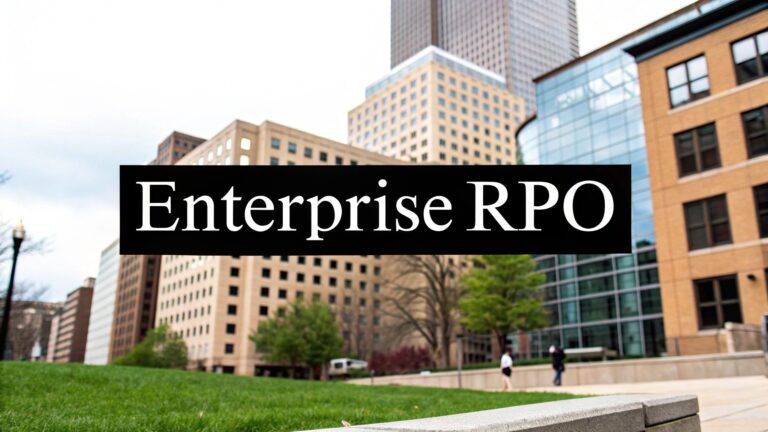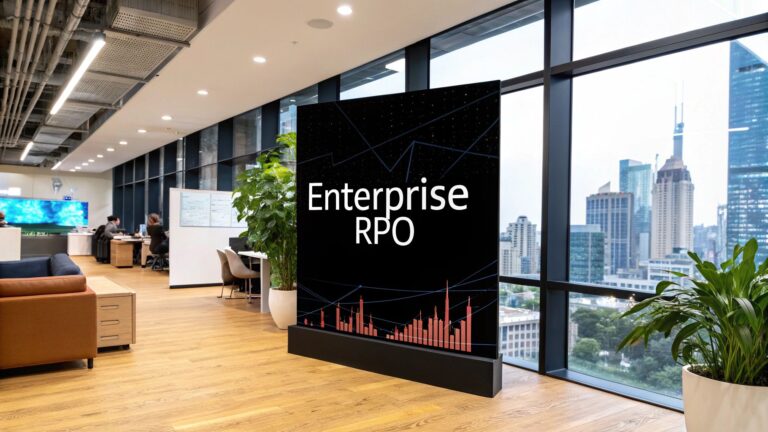In today’s competitive talent market, interview techniques can either make or break your hiring success. It is no longer about ‘hiring candidates’ using traditional formats like generic Q&As or gut-feel judgments.
With evolving workforce expectations, remote hiring trends, and AI-driven assessments, HR leaders must refine their strategies to attract and retain top talent.
And companies incorporating modern interview techniques are giving way to more structured, analytical, and tech-centered approaches, where ‘hiring right’ is all about skills-based hiring talent and equivalent focus on candidate’s potential to adapt and become a cultural fit.
For HR executives, generalists, and hiring managers, understanding and applying modern interview techniques can be the game-changer that ensures top-tier talent acquisition.
This blog will explore the evolving world of interview techniques, reflecting recent hiring trends, data-backed strategies, and best practices to help HR professionals refine their hiring approach.
Why Modern Interview Techniques Matter More Than Ever?
The hiring landscape is evolving rapidly. Gartner’s 2025 HR Trends report predicts that 70% of organizations will prioritize skills-based hiring, driven by automation and hybrid work. Traditional interviews can’t keep up- they’re too subjective, time-consuming, and disconnected from job realities.
Thus, modern interview techniques are the need of the hour. HR executives, generalists, and managers must implement the given strategic interview techniques to build high-performing teams.
- Structured Interviews
- Competency-Based Interviews
- AI-Powered Video Interviews
- Panel Interviews
- Situational Judgment Tests (SJTs)
- Cultural Fit Interviews
- Work Simulations
- Data-Driven Interview Analytics
HR leaders can transform recruitment into a strategic advantage by integrating these interview techniques and address the these challenges head on-
- Bias Reduction: Structured interviews and AI tools minimize subjective judgments.
- Efficiency: Video interviews and analytics streamline high-volume hiring.
- Accuracy: SJTs, simulations, and competency-based interviews predict performance.
- Retention: Cultural fit assessments ensure long-term alignment.
Let’s explore the best interview techniques in 2025.
1. Structured Interviews: The Backbone of Fair Hiring
Unstructured interviews are a breeding ground for bias, with McKinsey research showing they’re 40% less effective at predicting job performance. Structured interviews, however, are the gold standard for fairness and accuracy.
By standardizing questions and evaluation criteria, they ensure every candidate is assessed equitably, making them essential in today’s diversity-focused hiring landscape.
Why It’s Critical:
- Reduces subjective judgments, aligning with DEI goals.
- Enhances candidate experience by ensuring consistency.
- Boosts hiring accuracy by focusing on job-relevant skills.
How to Implement:
- Develop a question bank with behavioral (“Tell me about a time…”) and situational (“How would you handle…”) prompts tailored to the role.
- Use a 1-5 scoring rubric to evaluate responses objectively.
- Train interviewers to follow the script, minimizing deviations.
Pro Tip: Leverage Taggd’s AI-powered digital hiring platform to supercharge structured interviews by getting a 360-degree Taggd Enriched Candidate Profile. This profile includes the exclusive Taggd Score (t. score), which aggregates critical data on candidate skills, experiences, and competencies that would typically take weeks to uncover.
This significantly reduces the hiring cycle from months to days. With structured interviews powered by real-time, validated candidate data, HR teams can make confident, bias-free hiring decisions faster than ever.
2. Competency-Based Interviews: Skills Over Credentials
Resumes don’t tell the full story. SHRM’s 2024 study reveals that 56% of hiring failures stem from inadequate skills assessment. Competency-based interviews shift the focus to proven abilities, making them vital for roles requiring problem-solving, leadership, or adaptability. In a skills-first economy, this talent acquisition technique ensures hires can deliver from day one.
Why It’s Critical:
- Aligns hiring with organizational needs, not just qualifications.
- Identifies candidates who can thrive in dynamic work environments.
- Reduces turnover by matching skills to job demands.
How to Implement:
- Map core competencies (e.g., problem-solving, collaboration) to the role using tools like skill-mapping software.
- Ask targeted questions like, “Describe a complex challenge you overcame.”
- Evaluate responses against a competency framework for consistency.
Pro Tip: Regularly update competency frameworks to reflect evolving job requirements, especially in tech-driven industries. Alternatively, use applicant tracking systems (ATS) to filter candidates based on competencies before interviews.
3. AI-Powered Interviews: Efficiency Meets Scale
Gartner predicts that by 2026, multiple corporate interviews will leverage AI in hiring. Asynchronous video interviews save time, expand talent pools, and reduce bias by focusing on skills over demographics to build effective teams. For organizations scaling rapidly, this interview technique is a game-changer.
Why It’s Critical:
- Enables global hiring by removing geographic barriers.
- Minimizes interviewer bias through standardized evaluations.
- Accelerates screening, cutting time-to-hire by up to 35%.
Check out how Taggd helped a leading Manufacturer accelerate hiring. Faced with slow time-to-fill, high offer drop rates, and rapid expansion needs, the company turned to Taggd’s AI-powered solutions.
The Result:
- 20% Faster Time-to-Fill: Taggd helped reduce hiring turnaround to just 31 days—faster than the industry average.
- Offer Drop Rates Cut to 11%: Personalized candidate experiences helped minimize declines.
- 350+ New Employees Onboarded in Under 10 Months: Enabling seamless team ramp-ups.
This real-world success proves how AI-enabled hiring solutions can accelerate screening, cutting time-to-hire by up to 35% while improving quality-of-hire.
How to Implement:
- Use AI tools to analyze tone, clarity, and content in candidate responses.
- Design one-way video prompts that test role-specific scenarios.
- Ensure transparency by informing candidates how AI evaluations work.
Pro Tip: Combine AI screening with human oversight to balance efficiency and empathy, maintaining a positive candidate experience.
4. Panel Interviews: Harnessing Collective Wisdom
Deloitte’s 2024 hiring report notes that panel interviews boost decision accuracy by 30% by incorporating diverse perspectives. In an era where collaboration drives innovation, this interview technique ensures hires align with team dynamics and organizational goals.
Why It’s Critical:
- Mitigates individual biases through multi-stakeholder input.
- Simulates real-world team interactions, testing interpersonal skills.
- Enhances buy-in from hiring teams, reducing post-hire conflicts.
How to Implement:
- Assemble a diverse panel including HR, managers, and team members.
- Assign specific competencies to each panelist for focused evaluation.
- Use digital scorecards for real-time feedback.
Pro Tip: Train panelists on bias awareness to ensure fair scoring, especially for underrepresented candidates.
5. Situational Judgment Tests (SJTs): Predicting Real-World Performance
Harvard Business Review’s 2023 study found that SJTs improve hiring success by 25% by simulating on-the-job challenges. As roles become more complex, SJTs are critical for assessing decision-making under pressure, making them a must-have interview technique.
Why It’s Critical:
- Provides insights into candidates’ practical judgment, not just theoretical knowledge.
- Aligns assessments with real job scenarios, improving fit.
- Scalable for high-volume hiring with pre-built test libraries.
How to Implement:
- Design scenarios like, “A client rejects your proposal. How do you respond?”
- Offer multiple-choice options with clear scoring criteria (e.g., Option B: “Discuss concerns calmly” scores highest).
Pro Tip: Validate SJTs with current employees to ensure scenarios reflect real challenges.
6. Cultural Fit Interviews: Building Long-Term Loyalty
McKinsey’s 2024 retention study shows that cultural alignment boosts employee retention by 27%. Cultural fit interviews assess values and work styles, ensuring hires thrive in your organization’s ecosystem. In a post-pandemic world prioritizing employee engagement, this interview technique is non-negotiable.
Why It’s Critical:
- Reduces turnover by aligning hires with company values.
- Fosters cohesive teams, enhancing collaboration.
- Supports employer branding by showcasing your culture.
How to Implement:
- Ask value-based questions like, “What does innovation mean to you?”
- Test work style fit with prompts like, “Do you prefer autonomy or structure?”
- Use employer retention strategies to define measurable cultural metrics.
Pro Tip: Avoid overemphasizing “fit” to exclude diverse perspectives—balance alignment with inclusivity.
7. Work Simulations: Testing Skills in Action
AIHR’s 2024 report highlights that work simulations predict job performance 29% better than traditional interviews. By mimicking real tasks, this interview technique ensures candidates can walk the talk, especially in technical or creative roles, also helping Talent Acquisition Specialists overcome recruitment challenges.
Why It’s Critical:
- Validates skills in real-world contexts, reducing hiring risks.
- Engages candidates by showcasing the role’s challenges.
- Differentiates top performers in competitive talent markets.
How to Implement:
- For developers, ask candidates to debug code live.
- For sales roles, request a 5-minute product pitch.
Pro Tip: Provide clear instructions and time limits to ensure fairness across candidates.
8. Data-Driven Interview Analytics: The Power of Insights
Data-driven hiring improves candidate and employee experience management. By tracking recruitment KPIs and metrics like time-to-hire and quality of hire, organizations can refine their interview techniques for maximum impact. In a metrics-obsessed world, analytics are the key to recruitment success.
Why It’s Critical:
- Identifies bottlenecks in the hiring process, saving time and costs.
- Measures candidate experience, reducing dropout rates (ideal: <20%).
- Links hiring decisions to performance outcomes, ensuring ROI.
How to Implement:
- Monitor time-to-hire (target: <30 days).
- Analyze quality of hire through post-hire performance reviews.
- Use dropout rate data to optimize interview stages.
Pro Tip: Share analytics with leadership to secure buy-in for process improvements.
The Future of Interview Techniques
As we move into 2025 and beyond, interview techniques will continue to evolve with technology and workforce expectations. AIHR predicts that future of HR trends will focus on upskilling and internal mobility, with Deloitte noting that strong internal mobility programs boost engagement by 30%.
Future interview techniques may include gamified assessments, virtual reality simulations, and predictive analytics to assess fit and potential.
By blending behavioral, competency-based, virtual, panel, and storytelling interview techniques, HR leaders can create a hiring process that not only attracts top talent but also builds a resilient, diverse, and engaged workforce.
Stay ahead by embracing these trends and tailoring your approach to your organization’s unique needs.







